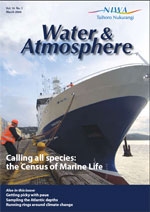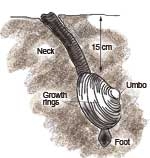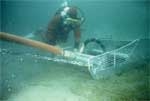PDF of this article (219 KB)





Growing commercial interest is raising questions about subtidal surf clams and sustainability of the resource. Lianos Triantafillos and Kimberley Maxwell are involved in a new survey to find the answers.
The surf zone of a high-energy sandy beach is a productive place, rich in diatoms and phytoplankton. Despite these attractions, there are only a few animals robust enough to survive the turbulent conditions and take advantage of this food source. One group of animals that thrives in the surf zone are the aptly named surf clams. Similar in appearance to pipi and cockles, surf clams have larger and thicker shells that protect them from the pounding waves, while their ability to burrow quickly into the sand stops them from being swept away.
In New Zealand, there are nine common species of surf clams. The toheroa (Paphies ventricosa) and tuatua (Paphies subtriangulata) are found in the intertidal zone. They are easily accessible at low tide and have been the basis of important hand-gathering fisheries. In comparison, the other surf clam species are much harder to access, primarily because they live in the breaker zone, often buried to a depth of up to 15 cm in the sand.
Where do subtidal surf clams live?
The biology of the seven species of subtidal surf clams is poorly understood, other than some information on their distribution and growth. Most of what is known about their distribution comes from a NIWA study that surveyed clam abundance at 16 beaches in the early 1990s and found that subtidal surf clams occupy depths ranging from 1 to 10 m, and each species was most abundant over a distinct depth range. The spatial abundance of surf clams was also patchy, with the highest densities found off the beaches of the Kapiti Coast, Cloudy Bay, and Pegasus Bay.
How fast do they grow?
Much of what is known about the growth of New Zealand surf clams comes from two NIWA studies, one investigating clams from Cloudy Bay in the South Island and the other focusing on clams collected from the North Island at Peka Peka and Ōtaki. Both these studies found the growth of subtidal surf clams was influenced by four factors:
- Age – surf clams grew rapidly in their first 3 years, but considerably slower there after.
- Season – individuals grew quickly in summer but hardly at all in winter.
- Location – South Island clams grew faster, and to a larger size, than the same species from the North Island.
- Depth in the surf zone – deeper water species, such as the ringed dosinia (Dosinia anus), had a life expectancy of up to 25 years, whereas that of the diamond shell (Spisula aequilatera), a species most abundant in shallower waters, was only about 5 years. This is despite both species growing to a similar size of 7 cm.
Survey to satisfy a growing appetite
All seven species of subtidal surf clams are edible. Last year, a little over 100 tonnes of surf clams were landed, most of which was exported to Asia. Surfco Ltd, the newly created commercial stakeholder group that controls most of the quota, plans to expand the size of this fishery. This group feels there is a lot of potential in surf clams because global demand for shellfish far outweighs supply.
To ensure that any expansion of this fishery will be sustainable, we need a better understanding of the distribution, abundance, and zonation of the surf clam resource, particularly in areas which are likely to be fished. To achieve this goal, NIWA scientists will undertake a series of surveys in several undeveloped fishery areas, such as the east coast of the North Island and from Tītahi Bay to Tīrua Point, north of Cape Egmont. We’ve chosen these sites because they have habitats that are likely to support persistent populations of surf clams, including extensive sandy beaches with relatively shallow profiles and surf conditions indicative of productive beaches.
Dredging for answers
To permit direct comparisons with previous surveys, we’ll use the same hydraulic dredge as that used in the early 1990s. This dredge is very efficient at catching clams because it pumps water into the sand ahead of the dredge, loosening the buried clams’ grip in the sand. The dredge bit combs through the resultant sand slurry and directs all clams, debris, and a small amount of sediment into the dredge path. All of these materials, except the larger clams and debris, filter back to the seabed through a grid on the underside of the dredge. This filtering action ensures the passage of the dredge has less effect on the environment than a passing wave.
Tag and return
Once we’ve determined the distribution, abundance, and zonation of the surf clams, we’ll collect information on their growth, mortality, and recruitment. One technique that we will use is tagging: thousands of individuals will be marked by shell notching and then returned to the seabed. When these clams are recaptured, their growth will be estimated by measuring how much they have grown during their time at liberty. We’ll also use sectioning to estimate their age by counting the number of annual rings in the umbo (the knob near the hinge) of the shell. These counts will help determine the size-at-age of individuals, and an analysis of the resultant age structures will be used to estimate mortality rates.
During this project, we’ll establish protocols to measure how these stocks respond to fishing by comparing growth, mortality, immigration, and emigration of adult and juvenile surf clams in fished and unfished areas. By the end of the three-year project we will have gained valuable insights into the fishery, knowledge that will help managers ensure the sustainability of this important resource.
Don’t clam up!
- There’s potentially a large global market for surf clams from New Zealand’s subtidal zone.
- Previous NIWA studies have established the basics about their habitat and growth patterns.
- A new survey will enlarge on earlier findings and establish protocols for sustainable harvest.
Further reading and a useful link
Cranfield, H.J.; Michael, K.P. (2001). Growth rates of five species of surf clams on a southern North Island beach, New Zealand. New Zealand Journal of Marine and Freshwater Research 35: 909–924.
Cranfield, H.J.; Michael, K.P. (2001). The surf clam fishery in New Zealand: description of the fishery,its management, and the biology of surf clams. New Zealand Fisheries Assessment Report 2001/62. 24 p.
Cranfield, H.J.; Michael, K.P.; Francis, R.I. (1996). Growth rates of five species of subtidal clam on a beach in the South Island, New Zealand. Marine & Freshwater Research 47(6): 773–784.
Michael, K.P.; Olsen, G.P.; Hvid, B.T.; Cranfield, H.J.(1990). Design and performance of two hydraulic subtidal clam dredges in New Zealand. New Zealand Fisheries Technical Report 21. 16 p.
Report from a surf clam aging workshop: www.nefsc.noaa.gov/nefsc/publications/crd/crd0612/
Dr Lianos Triantafillos works with invertebrate fisheries, and Kimberley Maxwell is a benthic ecologist and a member of Te Kūwaha o Taihoro Nukurangi (NIWA’s Māori Research & Development Group). They are both based in Wellington.
The surf clam project is funded by Seafood Innovations Ltd and sponsored by Surfco Ltd.
Teachers’ resource for NCEA Achievement Standards or Unit Standards: Biology Level 1 AS90164, US6294,Level 2 AS90460, AS90461 Science Level 3 US21613
